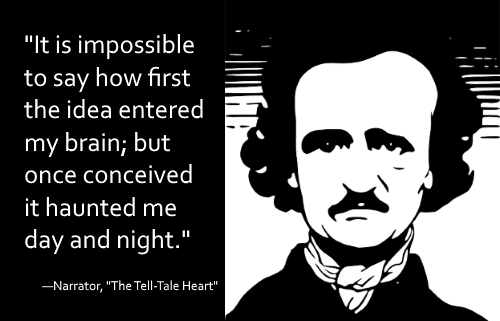If you’re not familiar with the work of Edgar Allen Poe, you might think “The Tell-Tale Heart” is a love story or maybe even a story about a jilted lover.
This is a clear case of why you shouldn’t judge a book by its cover (or a short story by its title). “The Tell-Tale Heart” is anything but a love story.
So if you’ve arrived at this post looking for help before actually reading the story, I suggest you read (and maybe listen to) the story first. (If you’re into reading about creepy insane murderers, you might be pleasantly surprised.)
Okay, now that we’re on the same page and are witnesses to the murder, let’s talk about how to write about this story. Once you know how, you can get started with your Tell-Tale Heart essay.

Understanding Literary Analysis
If you want to write a good literary analysis (and I assume you do), you need to read the literature carefully and understand what it’s about. A good literary analysis doesn’t mean that you can just summarize the plot.
Of course, you need to be able to summarize, and summarizing will be a useful skill when writing your paper, but literary analysis is about analysis, not summary.
Writing a literary analysis is your chance to show off your knowledge of all those literary terms you’ve been learning about, such as theme, symbolism, tone, and point of view.
Today, we’re focusing on the specifics of “The Tell-Tale Heart” though, not literary analysis in general. But if you want more help with understanding literary analysis, check out these resources:
- How to Write a Literary Analysis That Works
- 8 Components of a Smart Literary Analysis
- Literary Analysis Tips From a Kibin Editor
- Writing About Literature: 9 Things You Need to Know
How to Write a Heartfelt Tell-Tale Heart Essay
How much information and what type of information you include in your analysis will, of course, depend on the focus of your paper. If, for instance, you’re supposed to be writing about symbolism, you won’t likely include a detailed analysis of theme.
One of the first things you’ll need to do is write a thesis statement so that you know the focus before you start.
If you’re not sure what to focus on in your Tell-Tale Heart essay, here are four ideas.
Narration and point of view
“The Tell-Tale Heart” is told in first-person point of view through the eyes of the narrator, a madman who commits a murder.
Why is this important to the story? Think about it. How reliable is the narration of an insane person? Readers only get to learn about the situation, other characters, and the narrator himself through his ramblings.
Not convinced that the type of narration makes a difference? Consider how the story might be different if it were told through the eyes of the old man who was murdered.
What might he think of the madman? What would the story be like if told from the perspective of the police officers or from a third person, omniscient narrator?
Symbolism
There are several symbols in “The Tell-Tale Heart,” but two of the most prominent are the old man’s heart and his eye. (Your essay might focus on a variety of symbols in the story or on just one.)
The old man’s heart: The narrator hears the old man’s heart beating even though it’s impossible because the old man is dead. The heart reveals the narrator’s conscience and symbolizes his humanity as he finally confesses.
The old man’s eye: Eyes are often said to be the windows to the soul. The madman focuses on the old man’s eye so intently, though, that the madman only sees the old man as an eye and nothing more.
The narrator is haunted by the eye, and he calls it “evil” and a “vulture.” These words more accurately describe (and symbolize) the narrator because he viciously hunts and kills the old man.
Style
If you’ve ever read an academic journal article, I’m sure that you’ve noticed that they’re usually filled with a lot of ginormous technical words and ridiculously long sentences. Academics just have a tendency to write that way.
Here’s an example:
“The aim of the study was to analyse the relative frequency of use of a range of operational research modelling approaches in health care, along with the specific domains of application and the level of implementation” (Source).
Try reading it aloud. You almost have to stop to take a breath!
Now take a look at a few sentences from “The Tell-Tale Heart”:
“Above all was the sense of hearing. I heard all things in the heaven and in the earth. I heard many things in the underworld. How, then, am I mad?”
Poe’s four sentences combined are shorter than one of the journal article’s. So what, right?
Here’s the so what.
If you’re reading the journal article, you’re reading slowly because the bigger words and compound sentence structure create more complex thoughts.
Academics are writing thoughtfully detailed articles. The purpose is for you (the reader) to move through the work at a slower pace—to pause, to reflect, and to internalize the information.
If you’re reading Poe’s sentences, you move through them quickly. Poe writes in short sentences to mimic speech. The short sentences allow the reader to read the story more quickly.
Sure, if you’re reading quickly you can get done with your reading assignment is no time flat, but that’s not Poe’s purpose in writing in short sentences.
These short sentences represent the scattered, frantic thoughts of a madman.
At the beginning of the story, his mind and thoughts are racing because of his insanity. His thoughts then become even more frantic due to his guilty conscience after he commits the murder and faces the police officers.
Character analysis
If you’re writing a character analysis about “The Tell-Tale Heart,” you’ll likely focus on the narrator. The narrator of this story is most certainly a madman.
One of the key pieces of evidence is the narrator’s own words when he tries to convince readers that he’s actually sane:
“True! Nervous — very, very nervous I had been and am! But why will you say that I am mad? The disease had sharpened my senses — not destroyed them.”
The fact that the narrator is so adamant of his sanity gives readers a glimpse into his madness.
As you develop the analysis in your Tell-Tale Heart essay, also consider what other elements you know about the madman. For instance, consider his living conditions, relationships with others, and so on. This will help you create a more detailed analysis.
Looking for more tips on writing a strong character analysis? Read How to Write a Character Analysis That Works and 2 Character Analysis Essay Examples with Character.
Connecting the Ideas

As you decide which elements to include in your Tell-Tale Heart essay, keep an important point in mind. You might be required to focus on one specific element, such as symbolism or a character. But you also could be assigned a more general analysis of the short story itself.
In this case, you could include several of the elements I’ve explained in this post. (Just make sure to read your assignment guidelines closely to know which path you need to take.)
Need a little inspiration to help figure out how to make the connections? Check out Let a Kibin editor help!


